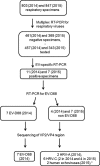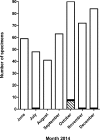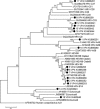Enterovirus D68 detection in respiratory specimens: Association with severe disease
- PMID: 28165146
- PMCID: PMC7167024
- DOI: 10.1002/jmv.24772
Enterovirus D68 detection in respiratory specimens: Association with severe disease
Abstract
Molecular techniques increased the number of documented respiratory infections. In a substantial number of cases the causative agent remains undetected. Since August 2014, an increase in Enterovirus(EV)-D68 infections was reported. We aimed to investigate epidemiology and clinical relevance of EV-D68. From June to December 2014 and from September to December 2015, 803 and 847 respiratory specimens, respectively, were tested for respiratory viruses with a multiplex RT-PCR. This multiplex RT-PCR does not detect EV-D68. Therefore, 457 (2014) and 343 (2015) specimens with negative results were submitted to an EV-specific-RT-PCR. EV-positive specimens were tested with an EV-D68-specific-RT-PCR and genotyped. Eleven specimens of 2014 tested positive in the EV-specific-RT-PCR and of these seven were positive in the EV-D68-specific-RT-PCR. Typing confirmed these as EV-D68. Median age of EV-D68-positive patients was 3 years (1 month-91 years). Common symptoms included fever (n = 6, 86%), respiratory distress (n = 5, 71%), and cough (n = 4, 57%). All EV-D68-positive patients were admitted to hospital, 4 (57%) were admitted to intensive care units and 6 (86%) received oxygen. One patient suffered from acute flaccid paralysis. Seven specimens of 2015 were positive in the EV-specific-RT-PCR but negative in the EV-D68-specific-RT-PCR. In conclusion, use of an EV-specific-RT-PCR allowed us to detect EV-D68 circulation in autumn 2014 that was not detected by the multiplex RT-PCR and was associated with severe disease.
Keywords: acute flaccid paralysis; human enterovirus 68; myelitis; respiratory tract infection; sequencing.
© 2017 Wiley Periodicals, Inc.
Figures




Similar articles
-
Molecular diversity and biennial circulation of enterovirus D68: a systematic screening study in Lyon, France, 2010 to 2016.Euro Surveill. 2018 Sep;23(37):1700711. doi: 10.2807/1560-7917.ES.2018.23.37.1700711. Euro Surveill. 2018. PMID: 30229724 Free PMC article.
-
High frequency of enterovirus D68 in children hospitalised with respiratory illness in Norway, autumn 2014.Influenza Other Respir Viruses. 2015 Mar;9(2):59-63. doi: 10.1111/irv.12300. Epub 2014 Dec 23. Influenza Other Respir Viruses. 2015. PMID: 25534826 Free PMC article.
-
Enterovirus D68 respiratory infection in a children's hospital in Japan in 2015.Pediatr Int. 2019 Aug;61(8):768-776. doi: 10.1111/ped.13903. Epub 2019 Aug 22. Pediatr Int. 2019. PMID: 31136073 Free PMC article.
-
The Emergence of Enterovirus-D68.Microbiol Spectr. 2016 Jun;4(3). doi: 10.1128/microbiolspec.EI10-0018-2016. Microbiol Spectr. 2016. PMID: 27337448 Review.
-
Global reemergence of enterovirus D68 as an important pathogen for acute respiratory infections.Rev Med Virol. 2015 Mar;25(2):102-14. doi: 10.1002/rmv.1820. Epub 2014 Dec 3. Rev Med Virol. 2015. PMID: 25471236 Free PMC article. Review.
Cited by
-
Genomic Analyses of Acute Flaccid Myelitis Cases among a Cluster in Arizona Provide Further Evidence of Enterovirus D68 Role.mBio. 2019 Jan 22;10(1):e02262-18. doi: 10.1128/mBio.02262-18. mBio. 2019. PMID: 30670612 Free PMC article.
-
Epidemiology and clinical manifestations of different enterovirus and rhinovirus types show that EV-D68 may still have an impact on severity of respiratory infections.J Med Virol. 2022 Aug;94(8):3829-3839. doi: 10.1002/jmv.27767. Epub 2022 Apr 18. J Med Virol. 2022. PMID: 35403229 Free PMC article.
-
Enterovirus D68 and acute flaccid myelitis-evaluating the evidence for causality.Lancet Infect Dis. 2018 Aug;18(8):e239-e247. doi: 10.1016/S1473-3099(18)30094-X. Epub 2018 Feb 23. Lancet Infect Dis. 2018. PMID: 29482893 Free PMC article. Review.
-
Clinical Presentation of Enterovirus D68 in a Swiss Pediatric University Center.Pediatr Infect Dis J. 2024 Dec 1;43(12):1135-1140. doi: 10.1097/INF.0000000000004503. Epub 2024 Aug 14. Pediatr Infect Dis J. 2024. PMID: 39163309 Free PMC article.
-
Mitophagosomes induced during EV-D68 infection promote viral nonlytic release.bioRxiv [Preprint]. 2024 Dec 6:2024.12.05.627125. doi: 10.1101/2024.12.05.627125. bioRxiv. 2024. PMID: 39677747 Free PMC article. Preprint.
References
-
- Jaramillo‐Gutierrez G, Benschop KS, Claas EC, et al. September through October 2010 multi‐centre study in the Netherlands examining laboratory ability to detect enterovirus 68, an emerging respiratory pathogen. J Virol Methods. 2013; 190:53–62. - PubMed
-
- Holm‐Hansen CC, Midgley SE, Fischer TK. Global emergence of enterovirus D68: a systematic review. Lancet Infect Dis. 2016. 5:64–75. - PubMed
-
- Poelman R, Schuffenecker I, Van Leer‐Buter C, Josset L, Niesters HG, Lina B. European surveillance for enterovirus D68 during the emerging North‐American outbreak in 2014. J Clin Virol. 2015b; 71:1–9. - PubMed
Publication types
MeSH terms
LinkOut - more resources
Full Text Sources
Other Literature Sources

